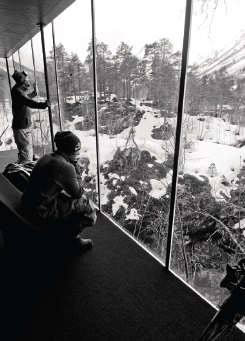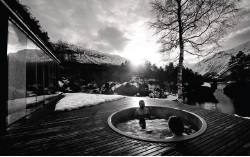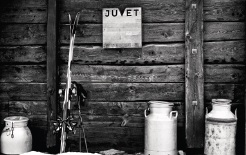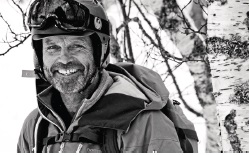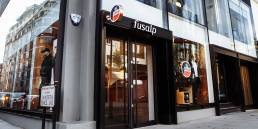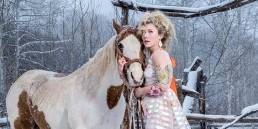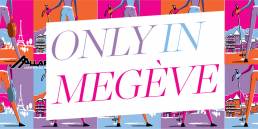Knut Slinning stands at the head of the heavy wooden table waiting for the ski-day chatter of his seated dinner guests to peter out. The proprietor of Juvet, a ski lodge in the west Norwegian fjords, is tall and lean, with a weathered look that reflects his passion for skiing and climbing. He speaks first in German, and then in English, the languages of his current guests. “Tonight we have deer sausage, which was hunted here and prepared by the chef
himself,” Slinning explains. Steaming main courses are placed in front of us: Cauliflower whipped into rich, cruciferous perfection; simple cabbage leaves that inexplicably sport an haute cuisine flair; and hearty venison in a starring role. This, he says, is new Nordic cooking—inspired preparations
of local, traditional fare using seasonal and sustainable ingredients. It also happens to be the perfect fuel for skiers.As we listen to Slinning (with tummies rumbling) I take in the ambiance. The plush dining room was once a part of an old, spacious cowshed tucked in a tiny, fertile farming valley above Balldal, Norway. Its provenance is fitting since it feels as if we worked the land today, though not in the traditional farming sense. Our hearty,
guiltless appetites stem instead from climbing and skiing the surrounding Sunnemøre Alps. In place of a farmer’s shovels and hoes, our tools are high-tech, lightweight alpine touring equipment, powder skis, and avalanche gear. I first heard of Juvet from a friend competing on the Freeride World Tour. The shine in her eyes as she described Juvet’s stunning minimalist glass cabins, sumptuous food, and exhilarating Norwegian skiing was more than enough to entice me to visit. I convinced another friend Liza to come along; we met in Oslo for a 55-minute flight northwest to Alesund, a colorful seaside city. Another 90 dizzying minutes on hairpin roads winding along the fjords brought us to the lodge.
Juvet, which simply means canyon in Norwegian, is immersed in overwhelming beauty. Ringed by snowy mountains on three sides, the lodge is situated on the mossy edge of the Gudbrandsjuvet, a deep and spectacular canyon created by the nearby river. When Juvet opened in 2010 it was labeled Europe’s first “landscape hotel.” Since then, it has become a destination where outdoors enthusiasts mix with tourists wishing to soak in the splendor. In the misty, gray evening light, Slinning leads us down an informal gravel driveway. As a man of the land, he moves easily over
the uneven landscape—our host was raised close to Juvet; there are those who describe him as a true “Viking.” He nimbly steers us toward the river, gesturing toward the cabins: squat, angular wood structures amongst the trees. Muddy, sloppy snow trails lead to each door. It isn’t until we step inside our cabin that we feel the transformative power of Juvet’s architecture. A luminescent canary-yellow bath offers the only color. Beyond that are bare walls, dark carpeted floors, a small sleeping nook, and one slim couch. With few décor details to distract us, Liza and I find our eyes drawn
instantly to a huge glass wall at one end of the room that seemingly opens to another world. The river swirls by, and the peaks beyond seem to be a part of our room—or, our room part of them. We feel as though we are already climbing and skiing among the crests beyond. At the hands of renowned Oslo architects Jensen and Skodvin, the seven, magical glass cabins at Juvet were created right on the banks of the Valldøla river. Each structure is perched on metal stilts so as not to disturb the natural setting, giving guests a feeling of lightness and seamless integration with the natural surroundings. The concept of a landscape hotel, Jan Olav Jensen explains, is to habituate and enjoy nature without disturbing it—the
buildings are crafted to bring attention to the outdoors—the structures themselves are not the focus. I could spend the day seated by these huge windows, drinking in the beauty of Juvet and its surrounding landscape. I do not need a television—or even a book—to pass the hours. I have enough simply with this curtain-free, high-definition window. Its view is that inviting. Yet the view is so enticing, we yearn to move outside as well.
We’ve come to ski, I remind myself, and we must get to it. Liza and I rise early the next morning to don our skis, skins, and light packs containing avy gear, layers, water, and lunch. I slip a hand-drawn map into my pocket—recommended alpine ski routes that Slinning has enthusiastically sketched for us—then we set off in search of a Norwegian-style snow adventure. We skin on easy, grippy snow up a track, first through stands of gnarled silver birch, then through a thick pine forest, gradually leaving the sparkling fjord far below. We pass traditional yellow-and-red farm buildings high on the mountainside, with no one but a few resilient Scandinavian ponies watching. Then we slip through the last stand of trees into the open. In front of us is a huge snowfield, sloping upwards toward the peaks we aim to ski. Like much of Norway’s glacially carved mountains, one flank offers easy
and gradual climbing access; the others offer cliffs, couloirs, and snow-covered steeps. Clouds flit by as we climb higher, scanning the terrain and the
map for ideal ski descents. We choose our first and drop in. The line, steep at first through two cliff faces, opens up into a 35-degree apron, topped with a few inches of fresh powder. Our joyful, high-speed arcs give the distinct sensation of flying above the fjord on a private playground of smooth, creamy powder. Thrilled, we head back up, again and again.
In the early evening we arrive back at Juvet, tired and happy. We climb down the steep and muddy path to the deck of the hotel’s relaxation center, built unobtrusively into the riverbank with one huge glass wall facing the river. Inside, we don’t choose the indoor sauna or the serene sitting rooms. We brave the cold in bikinis and bare feet, heading for the outdoor hot tub sunk into the deck just feet from the river. We immerse ourselves, cracking two beers from the local brewery, discussing our beautiful ski day and the future of our stay. Tomorrow could be a day to discover Strandafjellet, a lift-served ski area nearby to which Slinning takes guests when conditions aren’t ideal for ski touring. But for now, it is back to our room, where those
high-def windows are patiently waiting. We sink into chairs and quietly watch the show that Norway’s nature channel is featuring.
When it is finally time for us to leave Juvet, we tear our eyes from the windows and haul our own bags back up the snowy trail. Slinning is saying goodbye to fellow guests, laughing heartily in response to a question they’ve posed: Does anyone ever ask for curtains for the huge glass panels? “No,” chuckles Slinning, “and if they did, they wouldn’t get any.”


